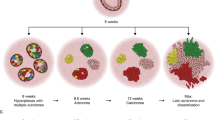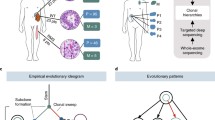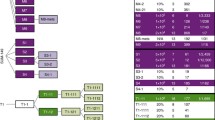Abstract
The properties of cell clones derived from locally growing and spontaneous metastases of 13762NF mammary adenocarcinoma change during in vitro growth. This has been termed phenotypic drift and is reproducible in independent experiments using different cryoprotected cell stocks. To determine whether phenotypic drift in 13762NF cell clones is the result of an en bloc shift in the properties of all tumor cells, or independent phenotypic divergence of tumor cells to produce a mixed cell population, local tumor-derived clone MTF7 was subcloned at low and high culture passage numbers in vitro. Each subclone was analyzed in vitro for cell morphology, growth rate, saturation density, karyotype and ploidy, and in vivo for experimental metastatic behavior. Subclones derived from low passage clone MTF7 (T11; tissue culture passage number 11) were relatively homogeneous in their growth rates (doubling times of 16·8–17·4 h) and saturation densities ( ∼ 2 × 105 cells/cm2); yet, these same subclones were heterogeneous in their in vitro cell morphologies, experimental metastatic potentials (means range from 0 to > 100 tumor nodules per lung), size distributions of lung tumor nodules, marker chromosomes and modal chromosome numbers. High passage MTF7 (T35; tissue culture passage number 35) subclones had similar growth rates and saturation densities, except for subclone 2, which had a doubling time of ∼ 26 h. Cell morphologies, experimental metastatic potentials (means range from 3 to > 600 tumor nodules per lung), size distribution of lung tumor nodules, marker chromosomes and modal chromosome numbers varied between MTF7 (T35) subclones. The results suggest that simultaneous, independent divergence of several phenotypes from a single cloned cell occurred to form a mixed cell population containing cells with independently segregated, unrelated phenotypes. Thus, the reproducibility of phenotypic drift in clonal cell populations was probably the result of tumor cell divergence and was not an en bloc shift in phenotypic properties of all cells.
Similar content being viewed by others
References
Dzarlieva, R., Schirrmacher, V., and Fusenig, N. F., 1982, Cytogenetic changes during tumor progression towards invasion, metastasis and immune escape in the EB/ESb model system. International Journal of Cancer, 30, 633–642.
Fidler, I. J., 1973, The relationship of embolic homogeneity, number, size, and viability to the incidence of experimental metastasis. European Journal of Cancer, 9, 223–227.
Fidler, I. J., and Nicolson, G. L., 1981, Immunobiology of experimental metastatic melanoma. Cancer Biology Reviews, Volume 2, edited by J. J. Marchalonis, M. G. Hanna and I. J. Fidler (New York: Marcel Dekker), pp. 171–234.
Fialkow, P. J., 1979, Clonal origin of human tumors. Annual Review of Medicine, 30, 135–176.
Foulds, L., 1956, The histologic analysis of mammary tumors of mice. 1. Scope of investigations and general principles of analysis. Journal of the National Cancer Institute, 17, 701–712.
Foulds, L., 1956, The histologic analysis of mammary tumors of mice. Journal of the National Cancer Institute, 17, 713–754.
Foulds, L., 1958, The natural history of cancer. Journal of Chronic Diseases, 8, 2–18.
Foulds, L., editor, 1975, Neoplastic Development (New York: Academic Press).
Greig, R. G., Caltabiano, L., Reid, R., Field, F., and Poste, G., 1983, Heterogeneity of protein phosphorylation in metastatic variants of B16 melanoma. Cancer Research, 43, 6057–6065.
Hart, I. R., and Fidler, I. J., 1981, The implications of tumor heterogeneity for studies on the biology and therapy of cancer metastasis. Biochimica et Biophysica Acta, 651, 37–50.
Heppner, G. H., 1984, Tumor heterogeneity. Cancer Research, 44, 2259–2265.
Heppner, G. H., and Miller, B. E., 1983, Tumor heterogeneity: biological implications and therapeutic consequences. Cancer Metastasis Reviews, 2, 5–23.
Kawaguchi, T., Kawaguchi, M., Miner, K. M., Lembo, T. M., and Nicolson, G. L., 1983, Brain meninges tumor formation by in vivo-selected metastasis B16 melanoma variants in mice. Clinical and Experimental Metastasis, 3, 247–259.
Liotta, L. A., Kleineriian, J. and Saidel, G. M., 1976, The significance of hematogenous tumor cell clumps in the metastatic process. Cancer Research, 36, 889–894.
Miller, B. E., Miller, F. R., Leith, J., and Heppner, G. H., 1980, Growth interaction in vivo between tumor subpopulations derived from a single mouse mammary tumor. Cancer Research, 40, 3977–3881.
Miner, K. M., Kawaguchi, T., Uba, G. W., and Nicolson, G. L., 1982, Clonal drift of cell surface, melanogenic and experimental metastatic properties of in vivo-selected brain meninges-colonizing murine B16 melanoma. Cancer Research, 42, 4631–4636.
Miner, K. M., Klostergaard, J., Granger, G. A., and Nicolson, G. L., 1983, Differences in cytotoxic effects of activated murine peritoneal macrophages and J774 monocytic cells on metastatic variants of B16 melanoma. Journal of the National Cancer Institute, 70, 717–724.
Neri, A., and Nicolson, G. L., 1981, Phenotypic drift of metastatic and cell-surface properties of mammary adenocarcinoma cell clones during growth in vivo. International Journal of Cancer, 28, 731–738.
Neri, A., Welch, D. R., Kawaguchi, T., and Nicolson, G. L., 1982, The development and biological properties of malignant cell sublines and clones of a spontaneously metastasizing rat mammary adenocarcinoma. Journal of the National Cancer Institute, 63(3),507–517.
Nicolson, G. L., 1982, Cancer metastasis: Organ colonization and the cell surface properties of malignant cells. Biochimica et Biophysica Acta, 695, 113–176.
Nicolson, G. L., 1984, Cell surface molecules and tumor metastasis. Regulation of metastatic diversity. Experimental Cell Research, 150, 3–22.
Nicolson, G. L., 1984, Generation of phenotypic diversity and progression in metastatic tumors. Cancer Metastasis Reviews, 3, 25–42.
Nicolson, G. L., 1984, Tumor progression, oncogenes and the evolution of metastatic phenotypic diversity. Clinical and Experimental Metastasis, 2, 85–105.
Nicolson, G. L., and Posts, G., 1982, Tumor cell diversity and host response in cancer metastasis. I. Properties of metastatic cells. Current Problems in Cancer, 7, 1–83.
Nicolson, G. L., and Posts, G., 1983, Tumor cell diversity and host responses in cancer metastasis. II. Host immune responses and therapy of metastases. Current Problems in Cancer, 7 (7), 1–43.
Nicolson, G. L., and Posts, G., 1983, Tumor implantation and invasion at metastatic sites. International Review of Experimental Pathology, 25, 77–181.
Nowell, P. C., 1976, The clonal evolution of tumor cell populations. Science, 194, 23–28.
Nowell, P. C., 1983, Tumor progression and clonal evolution: The role of genetic instability. Chromosome Mutation and Neoplasia, edited by J. German (New York: A. R. Liss), pp. 413–432.
Pearce, V., Pathak, S., Mellard, D., Welch, D. R., and Nicolson, G. L., 1984, Chromosome and DNA analysis of rat 13762NF mammary adenocarcinoma cell lines and clones of different metastatic potentials. Clinical and Experintental metastasis, 2, 271–286.
Peterson, J. A., Ceriani, R. L., Blank, E. W., and Osvaldo, L., 1983, Comparison of rates of phenotypic variability in surface antigen expression in normal and cancerous human breast epithelial cells. Cancer Research, 43, 4291–4296.
Poste, G., 1982, Experimental systems for analysis of the malignant phenotype. Cancer Metastasis Reviews, 1, 141–199.
Poste, G., Bucana, C., Raz, A., Bugelski, P., Kirsh, R., and Fidler, I. J., 1982, Analysis of the fate of systemically administered liposomes and implications for their use in drug delivery. Cancer Research, 42, 1412–1422.
Poste, G., Doll, J., Brown, A. E., Tzeng, J., and Zeidman, I., 1982, A comparison of the metastatic properties of B16 melanoma clones isolated from cultured cell lines, subcutaneous tumors and individual lung metastases. Cancer Research, 41, 2770–2778.
Poste, G., Doll, J., and Fidler, I. J., 1981, Interactions among clonal subpopulations affect stability of the metastatic phenotype in polyclonal populations of B16 melanoma cells. Proceedings of the National Academy of Sciences, U.S.A., 78, 6226–6230.
Poste, G., and Greig, R., 1982, On the genesis and regulation of cellular heterogeneity in malignant tumors. Invasion and Metastasis, 2, 137–176.
Raz, A., 1984, The demonstration of nonlinear development of experimental tumor lung metastases. Clinical and Experimental Metastasis, 2, 5–14.
Reading, C. L., Kraemer, P. M., Miner, K. M., and Nicolson, G. L., 1983, In vivo and in vitro properties of malignant variants of RAW117 metastatic murine lymphoma/lymphosarcoma. Clinical and Experimental Metastasis, 1, 135–151.
Schirrmacher, V., 1980, Shifts in tumor cell phenotypes induced by signals from the microenvironment. Relevance for the immunobiology of cancer metastasis. Immunobiology, 157, 89–98.
Steck, P. A., and Nicolson, G. L., 1983, Cell surface glycoproteins of 13762NF mammary adenocarcinoma clones of differing metastatic potentials. Experimental Cell Research, 147, 255–267.
Tanigawa, N., Mizuno, Y., Hashimura, T., Honda, K., Satomura, K., Hikasa, Y., Niwa, O., Sugahara, T., Yoshida, O., Kern, D. H., and Morton, D. L., 1984, Comparison of drug sensitivity among tumor cells within a tumor, between primary tumor and metastases, and between different metastases in the human tumor colonyforming assay. Cancer Research, 44, 2309–2312.
Tomasovic, S. P., Thames, H. D. Jr., and Nicolson, G. L., 1982, Heterogeneity in hyperthermic sensitivities of rat 13762NF mammary adenocarcinoma cell clones of differing metastatic potentials. Radiation Research, 91, 555–563.
Tsuruo, T., and Fidler, I. J., 1981, Differences in drug sensitivity among tumor cells from parental tumors, selected variants, and spontaneous metastases. Cancer Research, 41, 3058–3064.
Welch, D. R., Evans, D. P., Tomasovic, S. P., Milas, L., and Nicolson, G. L., 1984, Multiple phenotypic divergence of mammary adenocarcinoma cell clones. 11. Sensitivity to radiation, hyperthermia and FUdR. Clinical and Experimental Metastasis, 2, 357–371.
Welch, D. R., Milas, L., Tomasovic, S. P., and Nicolson, G. L., 1983, Heterogeneous response and clonal drift of sensitivities of metastatic 13762NF mammary adenocarcinoma clones to gamma radiation in vitro. Cancer Research, 43, 6–10.
Welch, D. R., Neri, A., and Nicolson, G. L., 1983, Comparison of ‘spontaneous’ and ‘experimental’ metastasis using rat 13762 mammary adenocarcinoma metastatic cell clones. Invasion and Metastasis, 3, 65–80.
Welch, D. R., and Nicolson, G. L., 1983, Phenotypic drift and heterogeneity in response of metastatic mammary adenocarcinoma cell clones to adriamycin, 5-fluoro-2'deoxyuridine and methotrexate treatment in vitro. Clinical and Experimental Metastasis, 1, 317–325.
Author information
Authors and Affiliations
Rights and permissions
About this article
Cite this article
Welch, D.R., Krizman, D.B. & Nicolson, G.L. Multiple phenotypic divergence of mammary adenocarcinoma cell clones. Clin Exp Metast 2, 333–355 (1984). https://doi.org/10.1007/BF00135172
Received:
Accepted:
Issue Date:
DOI: https://doi.org/10.1007/BF00135172




